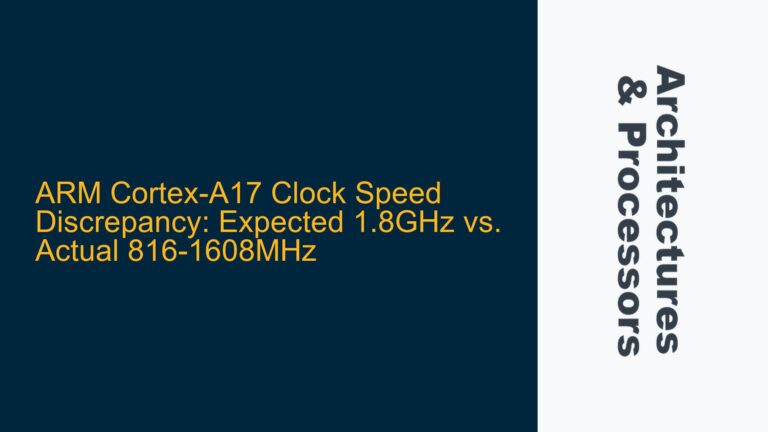ARM Cortex-M4 Dynamic Loading HardFault Due to Uninitialized R9 Register
The core issue revolves around dynamically loading position-independent code (PIC) into RAM on an ARM Cortex-M4 microcontroller and executing it. The problem manifests as a HardFault when the dynamically loaded function attempts to execute a blx r1 instruction, where r1 is uninitialized or incorrectly set to zero. This causes the program to jump to an invalid memory location (0x00), leading to a crash. The root cause lies in the improper handling of the R9 register, which is expected to point to an offset table for accessing global or static variables within the dynamically loaded code. The generated assembly code includes a blx r1 instruction that assumes r1 is correctly initialized, but this assumption fails, resulting in the HardFault.
The issue is further complicated by the fact that the code relies on a script to generate the binary function data, which does not account for the runtime initialization of the R9 register. The script generates assembly code that includes a mov.w r1, #28 instruction, followed by ldr r1, [r1, #0], which attempts to load a value from memory into r1. However, the memory location at offset 28 is not properly set up, leading to r1 being zero. This highlights a critical gap in the dynamic loading process: the absence of a mechanism to initialize the R9 register and provide the necessary offset table for the dynamically loaded code.
Memory Initialization and Register Setup for Position-Independent Code
The primary cause of the HardFault is the lack of proper initialization of the R9 register, which is essential for position-independent code to access global or static variables. In the ARM Cortex-M architecture, R9 is often used as a base register for accessing data relative to the current code location. When dynamically loading code, the R9 register must be set to point to an offset table that contains the addresses of global or static variables used by the loaded function. Without this initialization, any attempt to access these variables will fail, leading to undefined behavior or a HardFault.
The generated assembly code includes the following sequence:
a: f04f 011c mov.w r1, #28
e: 6809 ldr r1, [r1, #0]
This sequence attempts to load a value from memory location 28 into r1. However, memory location 28 is not properly initialized, causing r1 to be zero. When the blx r1 instruction is executed, the program attempts to jump to address 0x00, resulting in a HardFault. This issue is compounded by the fact that the script used to generate the binary function data does not account for the runtime initialization of the R9 register or the offset table.
Another contributing factor is the use of the -fPIC (Position Independent Code) flag during compilation. While this flag is necessary for generating position-independent code, it also introduces additional complexity in terms of register usage and memory access. The -fPIC flag causes the compiler to generate code that relies on the R9 register for accessing global or static variables. However, the dynamic loading process does not initialize R9, leading to the observed issues.
Implementing R9 Initialization and Offset Table Management
To resolve the HardFault issue and enable successful dynamic loading of position-independent code on the Cortex-M4, the following steps must be taken:
-
Initialize the R9 Register: Before executing the dynamically loaded code, the R9 register must be initialized to point to an offset table. This table contains the addresses of global or static variables used by the loaded function. The offset table should be created during the dynamic loading process and stored in a known memory location. The R9 register can then be initialized to point to this location before the loaded code is executed.
-
Modify the Binary Function Data: The binary function data generated by the script must be modified to include the necessary instructions for initializing the R9 register. This can be done by adding a preamble to the binary function data that sets R9 to the correct value. The preamble should be executed before the main function code to ensure that R9 is properly initialized.
-
Update the Dynamic Loading Process: The dynamic loading process must be updated to handle the creation and management of the offset table. This includes allocating memory for the offset table, populating it with the addresses of global or static variables, and ensuring that the R9 register is initialized correctly before executing the loaded code.
-
Verify Memory Access: After initializing the R9 register and executing the loaded code, it is essential to verify that memory access is functioning correctly. This can be done by adding debug statements or using a debugger to inspect the values of global or static variables accessed by the loaded function. Any discrepancies should be addressed by revisiting the offset table and R9 initialization process.
-
Optimize for Performance: Once the basic functionality is working, the dynamic loading process can be optimized for performance. This includes minimizing the overhead associated with creating and managing the offset table, as well as reducing the size of the binary function data by removing unnecessary instructions.
By following these steps, the HardFault issue can be resolved, and dynamic loading of position-independent code on the Cortex-M4 can be successfully implemented. The key is to ensure that the R9 register is properly initialized and that the offset table is correctly managed throughout the dynamic loading process. This approach not only addresses the immediate issue but also provides a robust framework for future dynamic loading implementations on ARM Cortex-M microcontrollers.






